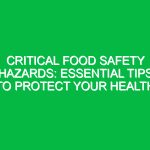Introduction
In the complex world of health, safety, and environmental (HSE) compliance, Material Safety Data Sheets (MSDS), now more commonly referred to as Safety Data Sheets (SDS), play a pivotal role. These documents serve as a vital source of information regarding the properties, hazards, safe handling, and emergency measures related to chemicals and substances used in various industries. Free MSDS safety sheets are readily available resources that can significantly aid organizations in adhering to HSE Regulations. This article will explore the importance of these sheets, the information they contain, and how they contribute to a safer workplace.
Understanding Free MSDS Safety Sheets
Free MSDS safety sheets are documents that provide comprehensive information about specific chemicals or substances. They detail crucial aspects such as:
- Identification of the substance and manufacturer
- Hazard identification
- Composition and information on ingredients
- First-aid measures
- Fire-fighting measures
- Accidental release measures
- Handling and storage guidelines
- Exposure controls and Personal Protection
- Toxicological information
These sheets are essential for various stakeholders, including employers, employees, emergency responders, and regulatory agencies. They ensure that everyone involved understands the potential risks associated with chemical substances and knows how to mitigate those risks.
Key Components of MSDS Safety Sheets
To fully grasp the significance of free MSDS safety sheets, it’s crucial to understand their components. Each section is designed to address specific safety concerns:
1. Identification
This section provides the name of the chemical, its synonyms, and contact information for the manufacturer or supplier. Accurate identification is vital for ensuring that users are aware of the exact substance they are handling.
2. Hazard Identification
Here, the Hazards associated with the chemical are detailed, including physical and health risks. This section informs users about the potential dangers, such as toxicity, flammability, and environmental Hazards.
3. Composition and Ingredients
This component lists the chemical components of the substance, including any impurities or additives. Understanding the composition is vital for assessing the risks and Safety Measures required.
4. First-Aid Measures
In the event of exposure or accidents, this section provides essential first-aid steps for various scenarios, such as inhalation, skin contact, or ingestion. This information can be lifesaving in emergencies.
5. Fire-Fighting Measures
This part outlines the appropriate firefighting techniques and materials to use in case of a fire involving the substance. Knowing how to respond in such situations can prevent catastrophic outcomes.
6. Accidental Release Measures
Should a spill or leak occur, this section provides guidance on containment and cleanup Procedures, as well as protective equipment needed during the response.
7. Handling and Storage
This section outlines proper methods for handling and storing the chemical to minimize risks. It includes recommendations for incompatible substances and environmental conditions.
8. Exposure Controls and Personal Protection
Here, the recommended Personal Protective Equipment (PPE) and engineering controls are detailed. Understanding these requirements is crucial for maintaining a safe work Environment.
9. Toxicological Information
This component provides data on the chemical’s health Effects, including routes of exposure, symptoms of exposure, and long-term effects. This information is essential for risk assessments and medical evaluations.
The Benefits of Utilizing Free MSDS Safety Sheets
Using free MSDS safety sheets has numerous benefits for organizations:
1. Compliance with Regulations
Adhering to local, national, and international regulations is a legal obligation for organizations that handle hazardous substances. Free MSDS safety sheets help companies meet these requirements, thereby avoiding penalties and maintaining their licenses to operate.
2. Enhanced Workplace Safety
By providing clear instructions and hazard information, free MSDS safety sheets empower employees to work safely with hazardous materials. This proactive approach fosters a culture of safety and responsibility.
3. Efficient Emergency Response
In emergencies, having immediate access to reliable information can be critical. Free MSDS safety sheets equip emergency responders with the knowledge needed to handle chemical incidents effectively.
4. Improved Risk Assessment
Free MSDS safety sheets provide essential data for conducting thorough risk assessments. This information enables organizations to implement appropriate Safety Measures and controls.
5. Cost Savings
Accessing free MSDS safety sheets can save organizations money on compliance Training and consultations. By leveraging readily available resources, companies can allocate funds to other safety initiatives.
Best Practices for Using Free MSDS Safety Sheets
While free MSDS safety sheets are invaluable, maximizing their effectiveness requires following Best Practices:
1. Regular Updates
Chemical formulations can change, so it’s essential to ensure that the MSDS being used is the most current version. Regularly checking for updates from suppliers can prevent the use of outdated information.
2. Employee Training
Training employees on how to read and understand MSDS safety sheets is crucial. Consider conducting training sessions that offer hands-on practice with real-life scenarios.
3. Accessibility
Make MSDS safety sheets easily accessible to all employees. Consider creating a central digital repository where these sheets are stored and can be retrieved quickly.
4. Integration into Safety Programs
Incorporate MSDS safety sheets into broader safety and health programs. This integration ensures that safety data is used in daily operations and emergency planning.
5. Encourage Reporting
Foster an environment where employees feel comfortable reporting safety concerns or incidents related to chemical handling. Addressing these issues promptly can enhance Workplace Safety.
Identifying Potential Hazards and Risks
It’s imperative to recognize that not all chemicals are created equal. Some substances pose significant risks that must be understood and managed effectively. For example, consider a hypothetical construction site where workers are using a solvent for cleaning equipment. If the MSDS for this solvent indicates that it is highly flammable and can cause respiratory issues, employers must take specific Precautions:
- Ensure proper ventilation in the area where the solvent is used
- Provide appropriate PPE, including gloves and respirators
- Store the solvent away from ignition sources
This scenario illustrates the importance of understanding the hazards associated with each chemical through their MSDS. It emphasizes the need for vigilance and proactive risk management in the workplace.
Regulations and Standards Governing MSDS Safety Sheets
Various regulations and standards govern the use of MSDS safety sheets, ensuring that they meet specific requirements. In the United States, for instance, the Occupational Safety and Health Administration (OSHA) mandates that all hazardous chemicals must have an accompanying SDS. This requirement falls under the Hazard Communication Standard (HCS), which aims to ensure that information about chemical hazards is communicated effectively.
Internationally, the Globally Harmonized System of Classification and Labelling of Chemicals (GHS) has set forth guidelines for creating and distributing safety data sheets. Adhering to these regulations not only ensures compliance but also enhances safety culture within organizations.
Conclusion
In summary, free MSDS safety sheets are an essential resource for any organization dealing with hazardous substances. They provide critical information that promotes health and safety in the workplace, ensuring compliance with regulations while enhancing emergency preparedness. By understanding their components, leveraging their benefits, and following Best Practices, organizations can foster a safer environment for their employees.
As you navigate the complexities of HSE compliance, consider the invaluable role that free MSDS safety sheets play in your safety strategy. Stay informed, stay safe, and prioritize the well-being of everyone in your workplace.


